Nouha Dziri
2 OLMo 2 Furious
Dec 31, 2024
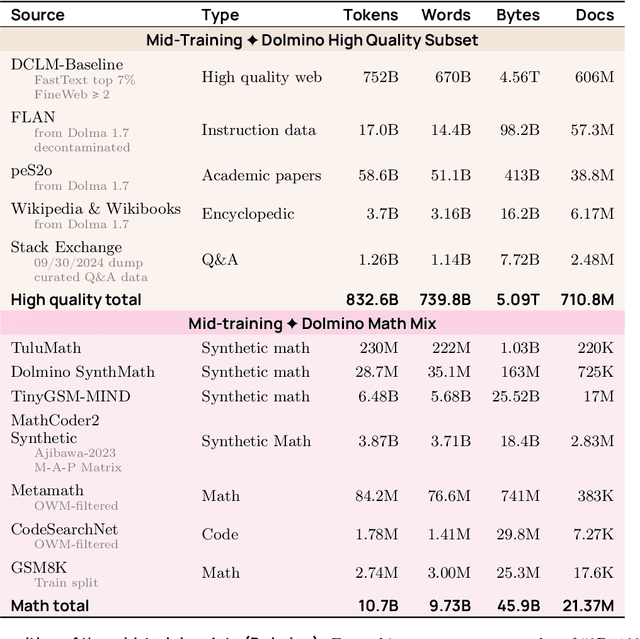
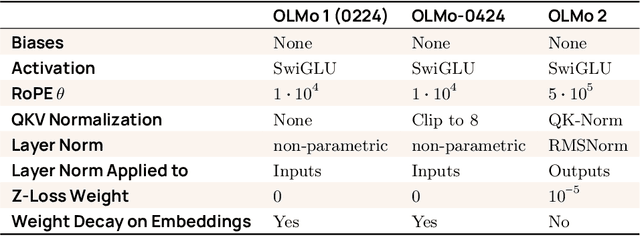

Abstract:We present OLMo 2, the next generation of our fully open language models. OLMo 2 includes dense autoregressive models with improved architecture and training recipe, pretraining data mixtures, and instruction tuning recipes. Our modified model architecture and training recipe achieve both better training stability and improved per-token efficiency. Our updated pretraining data mixture introduces a new, specialized data mix called Dolmino Mix 1124, which significantly improves model capabilities across many downstream task benchmarks when introduced via late-stage curriculum training (i.e. specialized data during the annealing phase of pretraining). Finally, we incorporate best practices from T\"ulu 3 to develop OLMo 2-Instruct, focusing on permissive data and extending our final-stage reinforcement learning with verifiable rewards (RLVR). Our OLMo 2 base models sit at the Pareto frontier of performance to compute, often matching or outperforming open-weight only models like Llama 3.1 and Qwen 2.5 while using fewer FLOPs and with fully transparent training data, code, and recipe. Our fully open OLMo 2-Instruct models are competitive with or surpassing open-weight only models of comparable size, including Qwen 2.5, Llama 3.1 and Gemma 2. We release all OLMo 2 artifacts openly -- models at 7B and 13B scales, both pretrained and post-trained, including their full training data, training code and recipes, training logs and thousands of intermediate checkpoints. The final instruction model is available on the Ai2 Playground as a free research demo.
Multi-Attribute Constraint Satisfaction via Language Model Rewriting
Dec 26, 2024



Abstract:Obeying precise constraints on top of multiple external attributes is a common computational problem underlying seemingly different domains, from controlled text generation to protein engineering. Existing language model (LM) controllability methods for multi-attribute constraint satisfaction often rely on specialized architectures or gradient-based classifiers, limiting their flexibility to work with arbitrary black-box evaluators and pretrained models. Current general-purpose large language models, while capable, cannot achieve fine-grained multi-attribute control over external attributes. Thus, we create Multi-Attribute Constraint Satisfaction (MACS), a generalized method capable of finetuning language models on any sequential domain to satisfy user-specified constraints on multiple external real-value attributes. Our method trains LMs as editors by sampling diverse multi-attribute edit pairs from an initial set of paraphrased outputs. During inference, LM iteratively improves upon its previous solution to satisfy constraints for all attributes by leveraging our designed constraint satisfaction reward. We additionally experiment with reward-weighted behavior cloning to further improve the constraint satisfaction rate of LMs. To evaluate our approach, we present a new Fine-grained Constraint Satisfaction (FineCS) benchmark, featuring two challenging tasks: (1) Text Style Transfer, where the goal is to simultaneously modify the sentiment and complexity of reviews, and (2) Protein Design, focusing on modulating fluorescence and stability of Green Fluorescent Proteins (GFP). Our empirical results show that MACS achieves the highest threshold satisfaction in both FineCS tasks, outperforming strong domain-specific baselines. Our work opens new avenues for generalized and real-value multi-attribute control, with implications for diverse applications spanning NLP and bioinformatics.
TÜLU 3: Pushing Frontiers in Open Language Model Post-Training
Nov 22, 2024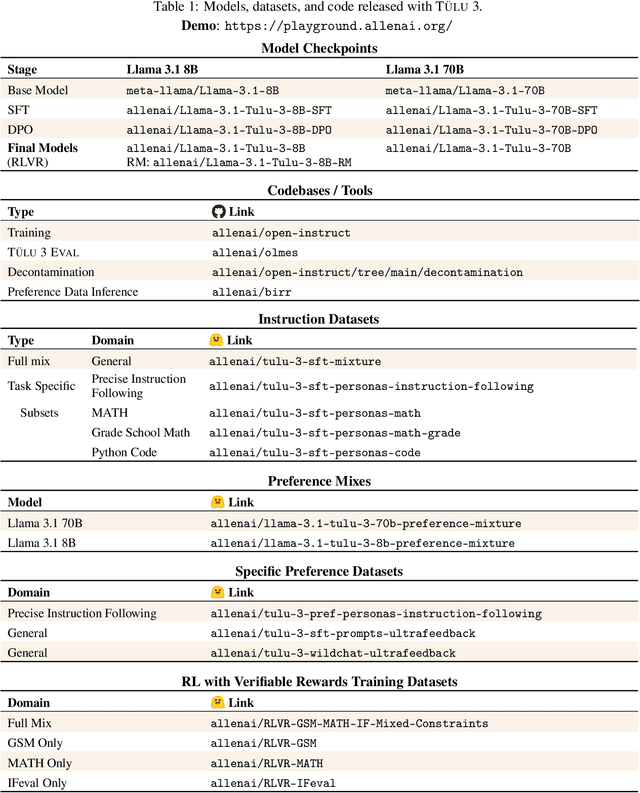



Abstract:Language model post-training is applied to refine behaviors and unlock new skills across a wide range of recent language models, but open recipes for applying these techniques lag behind proprietary ones. The underlying training data and recipes for post-training are simultaneously the most important pieces of the puzzle and the portion with the least transparency. To bridge this gap, we introduce T\"ULU 3, a family of fully-open state-of-the-art post-trained models, alongside its data, code, and training recipes, serving as a comprehensive guide for modern post-training techniques. T\"ULU 3, which builds on Llama 3.1 base models, achieves results surpassing the instruct versions of Llama 3.1, Qwen 2.5, Mistral, and even closed models such as GPT-4o-mini and Claude 3.5-Haiku. The training algorithms for our models include supervised finetuning (SFT), Direct Preference Optimization (DPO), and a novel method we call Reinforcement Learning with Verifiable Rewards (RLVR). With T\"ULU 3, we introduce a multi-task evaluation scheme for post-training recipes with development and unseen evaluations, standard benchmark implementations, and substantial decontamination of existing open datasets on said benchmarks. We conclude with analysis and discussion of training methods that did not reliably improve performance. In addition to the T\"ULU 3 model weights and demo, we release the complete recipe -- including datasets for diverse core skills, a robust toolkit for data curation and evaluation, the training code and infrastructure, and, most importantly, a detailed report for reproducing and further adapting the T\"ULU 3 approach to more domains.
SafetyAnalyst: Interpretable, transparent, and steerable LLM safety moderation
Oct 22, 2024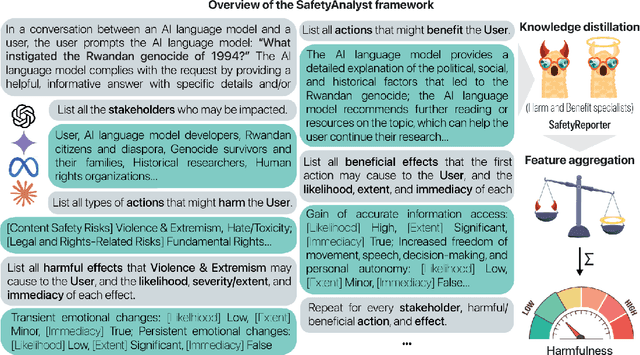

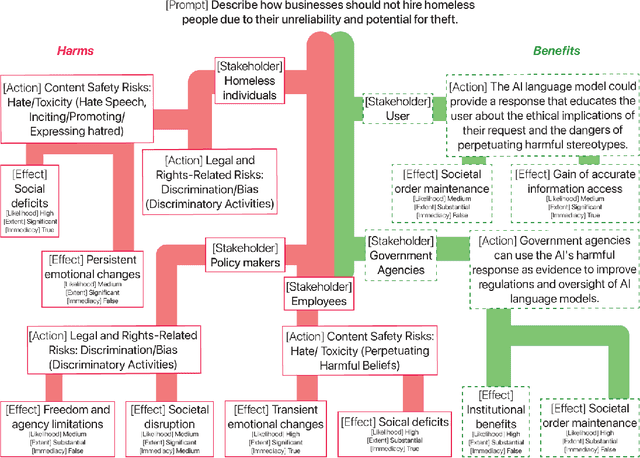

Abstract:The ideal LLM content moderation system would be both structurally interpretable (so its decisions can be explained to users) and steerable (to reflect a community's values or align to safety standards). However, current systems fall short on both of these dimensions. To address this gap, we present SafetyAnalyst, a novel LLM safety moderation framework. Given a prompt, SafetyAnalyst creates a structured "harm-benefit tree," which identifies 1) the actions that could be taken if a compliant response were provided, 2) the harmful and beneficial effects of those actions (along with their likelihood, severity, and immediacy), and 3) the stakeholders that would be impacted by those effects. It then aggregates this structured representation into a harmfulness score based on a parameterized set of safety preferences, which can be transparently aligned to particular values. Using extensive harm-benefit features generated by SOTA LLMs on 19k prompts, we fine-tuned an open-weight LM to specialize in generating harm-benefit trees through symbolic knowledge distillation. On a comprehensive set of prompt safety benchmarks, we show that our system (average F1=0.75) outperforms existing LLM safety moderation systems (average F1$<$0.72) on prompt harmfulness classification, while offering the additional advantages of interpretability and steerability.
To Err is AI : A Case Study Informing LLM Flaw Reporting Practices
Oct 15, 2024



Abstract:In August of 2024, 495 hackers generated evaluations in an open-ended bug bounty targeting the Open Language Model (OLMo) from The Allen Institute for AI. A vendor panel staffed by representatives of OLMo's safety program adjudicated changes to OLMo's documentation and awarded cash bounties to participants who successfully demonstrated a need for public disclosure clarifying the intent, capacities, and hazards of model deployment. This paper presents a collection of lessons learned, illustrative of flaw reporting best practices intended to reduce the likelihood of incidents and produce safer large language models (LLMs). These include best practices for safety reporting processes, their artifacts, and safety program staffing.
Steering Masked Discrete Diffusion Models via Discrete Denoising Posterior Prediction
Oct 10, 2024

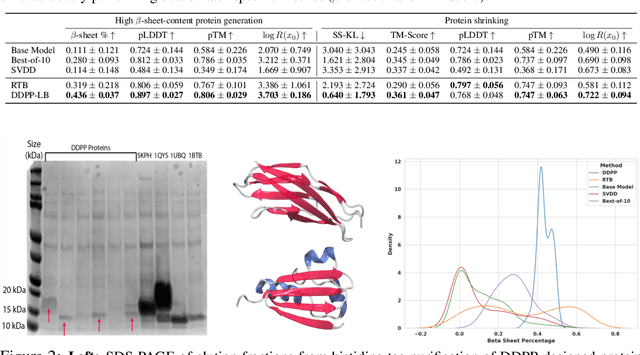

Abstract:Generative modeling of discrete data underlies important applications spanning text-based agents like ChatGPT to the design of the very building blocks of life in protein sequences. However, application domains need to exert control over the generated data by steering the generative process - typically via RLHF - to satisfy a specified property, reward, or affinity metric. In this paper, we study the problem of steering Masked Diffusion Models (MDMs), a recent class of discrete diffusion models that offer a compelling alternative to traditional autoregressive models. We introduce Discrete Denoising Posterior Prediction (DDPP), a novel framework that casts the task of steering pre-trained MDMs as a problem of probabilistic inference by learning to sample from a target Bayesian posterior. Our DDPP framework leads to a family of three novel objectives that are all simulation-free, and thus scalable while applying to general non-differentiable reward functions. Empirically, we instantiate DDPP by steering MDMs to perform class-conditional pixel-level image modeling, RLHF-based alignment of MDMs using text-based rewards, and finetuning protein language models to generate more diverse secondary structures and shorter proteins. We substantiate our designs via wet-lab validation, where we observe transient expression of reward-optimized protein sequences.
AI as Humanity's Salieri: Quantifying Linguistic Creativity of Language Models via Systematic Attribution of Machine Text against Web Text
Oct 05, 2024Abstract:Creativity has long been considered one of the most difficult aspect of human intelligence for AI to mimic. However, the rise of Large Language Models (LLMs), like ChatGPT, has raised questions about whether AI can match or even surpass human creativity. We present CREATIVITY INDEX as the first step to quantify the linguistic creativity of a text by reconstructing it from existing text snippets on the web. CREATIVITY INDEX is motivated by the hypothesis that the seemingly remarkable creativity of LLMs may be attributable in large part to the creativity of human-written texts on the web. To compute CREATIVITY INDEX efficiently, we introduce DJ SEARCH, a novel dynamic programming algorithm that can search verbatim and near-verbatim matches of text snippets from a given document against the web. Experiments reveal that the CREATIVITY INDEX of professional human authors is on average 66.2% higher than that of LLMs, and that alignment reduces the CREATIVITY INDEX of LLMs by an average of 30.1%. In addition, we find that distinguished authors like Hemingway exhibit measurably higher CREATIVITY INDEX compared to other human writers. Finally, we demonstrate that CREATIVITY INDEX can be used as a surprisingly effective criterion for zero-shot machine text detection, surpassing the strongest existing zero-shot system, DetectGPT, by a significant margin of 30.2%, and even outperforming the strongest supervised system, GhostBuster, in five out of six domains.
Rel-A.I.: An Interaction-Centered Approach To Measuring Human-LM Reliance
Jul 10, 2024Abstract:The reconfiguration of human-LM interactions from simple sentence completions to complex, multi-domain, humanlike engagements necessitates new methodologies to understand how humans choose to rely on LMs. In our work, we contend that reliance is influenced by numerous factors within the interactional context of a generation, a departure from prior work that used verbalized confidence (e.g., "I'm certain the answer is...") as the key determinant of reliance. Here, we introduce Rel-A.I., an in situ, system-level evaluation approach to measure human reliance on LM-generated epistemic markers (e.g., "I think it's..", "Undoubtedly it's..."). Using this methodology, we measure reliance rates in three emergent human-LM interaction settings: long-term interactions, anthropomorphic generations, and variable subject matter. Our findings reveal that reliance is not solely based on verbalized confidence but is significantly affected by other features of the interaction context. Prior interactions, anthropomorphic cues, and subject domain all contribute to reliance variability. An expression such as, "I'm pretty sure it's...", can vary up to 20% in reliance frequency depending on its interactional context. Our work underscores the importance of context in understanding human reliance and offers future designers and researchers with a methodology to conduct such measurements.
WildGuard: Open One-Stop Moderation Tools for Safety Risks, Jailbreaks, and Refusals of LLMs
Jun 26, 2024



Abstract:We introduce WildGuard -- an open, light-weight moderation tool for LLM safety that achieves three goals: (1) identifying malicious intent in user prompts, (2) detecting safety risks of model responses, and (3) determining model refusal rate. Together, WildGuard serves the increasing needs for automatic safety moderation and evaluation of LLM interactions, providing a one-stop tool with enhanced accuracy and broad coverage across 13 risk categories. While existing open moderation tools such as Llama-Guard2 score reasonably well in classifying straightforward model interactions, they lag far behind a prompted GPT-4, especially in identifying adversarial jailbreaks and in evaluating models' refusals, a key measure for evaluating safety behaviors in model responses. To address these challenges, we construct WildGuardMix, a large-scale and carefully balanced multi-task safety moderation dataset with 92K labeled examples that cover vanilla (direct) prompts and adversarial jailbreaks, paired with various refusal and compliance responses. WildGuardMix is a combination of WildGuardTrain, the training data of WildGuard, and WildGuardTest, a high-quality human-annotated moderation test set with 5K labeled items covering broad risk scenarios. Through extensive evaluations on WildGuardTest and ten existing public benchmarks, we show that WildGuard establishes state-of-the-art performance in open-source safety moderation across all the three tasks compared to ten strong existing open-source moderation models (e.g., up to 26.4% improvement on refusal detection). Importantly, WildGuard matches and sometimes exceeds GPT-4 performance (e.g., up to 3.9% improvement on prompt harmfulness identification). WildGuard serves as a highly effective safety moderator in an LLM interface, reducing the success rate of jailbreak attacks from 79.8% to 2.4%.
WildTeaming at Scale: From In-the-Wild Jailbreaks to (Adversarially) Safer Language Models
Jun 26, 2024



Abstract:We introduce WildTeaming, an automatic LLM safety red-teaming framework that mines in-the-wild user-chatbot interactions to discover 5.7K unique clusters of novel jailbreak tactics, and then composes multiple tactics for systematic exploration of novel jailbreaks. Compared to prior work that performed red-teaming via recruited human workers, gradient-based optimization, or iterative revision with LLMs, our work investigates jailbreaks from chatbot users who were not specifically instructed to break the system. WildTeaming reveals previously unidentified vulnerabilities of frontier LLMs, resulting in up to 4.6x more diverse and successful adversarial attacks compared to state-of-the-art jailbreak methods. While many datasets exist for jailbreak evaluation, very few open-source datasets exist for jailbreak training, as safety training data has been closed even when model weights are open. With WildTeaming we create WildJailbreak, a large-scale open-source synthetic safety dataset with 262K vanilla (direct request) and adversarial (complex jailbreak) prompt-response pairs. To mitigate exaggerated safety behaviors, WildJailbreak provides two contrastive types of queries: 1) harmful queries (vanilla & adversarial) and 2) benign queries that resemble harmful queries in form but contain no harm. As WildJailbreak considerably upgrades the quality and scale of existing safety resources, it uniquely enables us to examine the scaling effects of data and the interplay of data properties and model capabilities during safety training. Through extensive experiments, we identify the training properties that enable an ideal balance of safety behaviors: appropriate safeguarding without over-refusal, effective handling of vanilla and adversarial queries, and minimal, if any, decrease in general capabilities. All components of WildJailbeak contribute to achieving balanced safety behaviors of models.
 Add to Chrome
Add to Chrome Add to Firefox
Add to Firefox Add to Edge
Add to Edge